06.24.2024
 Dr. Bhavani Thuraisingham, Founders Chair in Engineering and Computer Science.
Dr. Bhavani Thuraisingham, Founders Chair in Engineering and Computer Science.
A new book about trailblazing women in computer science highlights Dr. Bhavani Thuraisingham’s journey, from growing up in Sri Lanka to becoming a respected academic at The University of Texas at Dallas and a renowned cybersecurity expert.
Rendering History: The Women of ACM-W, published in April by the Association for Computing Machinery, celebrates the 30-year history of the association’s Committee on Women in Computing (ACM-W). The book includes first-person stories from Thuraisingham and other women leaders in the field.
ACM-W formed in 1993 to provide community and support to women in computer science through lecture opportunities, awards and advocacy programs to encourage more young women to enter the male-dominated field. In 2020, women received 21% of computer science bachelor’s degrees, according to the National Science Foundation National Center for Science and Engineering Statistics.
Rendering History features stories of 37 women who made history in computer science, including pioneering mathematician and programmer Ada Lovelace and the original programmers of the first general purpose computer, ENIAC (Electronic Numerical Integrator and Computer), which was introduced in 1945.
 Rendering History: The Women of ACM-W celebrates the 30-year history of the Association for Computing Machinery’s Committee on Women in Computing.
Rendering History: The Women of ACM-W celebrates the 30-year history of the Association for Computing Machinery’s Committee on Women in Computing.
Thuraisingham’s contributions to computer science are extensive, said Dr. Gloria Childress Townsend, chair of computer science at DePauw University, who edited the book.
“Bhavani’s story fascinates me. Her captivating journey from Ceylon [now Sri Lanka] to The University of Texas at Dallas would appeal to any reader,” she said. “Whereas many computer scientists lend their expertise to one subfield alone, Bhavani extended her theoretical computing roots to cybersecurity, machine learning, database systems, cloud computing and data science.”
In the book, Thuraisingham tells about growing up in Sri Lanka’s minority Tamil community, which faced discrimination that included quotas limiting opportunities for college and jobs. She excelled in the Catholic schools she attended run by Irish nuns, even skipping grades, and in 1972 enrolled in the former University of Ceylon to study math and physics.
Courses in computer science, an emerging field at the time, were not available at Sri Lankan universities. In one of her classes, however, Thuraisingham learned Fortran, the first widely used programming language.
“That was when I was introduced to computer programming in Fortran and wrote my first program and used punched cards to submit the job to the computer center that then had just one machine,” Thuraisingham wrote. “I was thrilled to get the results of the first program.”
To study computer science in graduate school, Thuraisingham would need to leave Sri Lanka, but in her conservative community, she was expected to get married first. Her father, who typically would have arranged her marriage, died just before she started college. So, her uncle arranged her marriage to Dr. Thevendra Thuraisingham, who was finishing his PhD at the University of Cambridge and wanted to marry a woman with a degree in physical sciences. After meeting her potential husband, Thuraisingham agreed to the union. The couple married in 1975 and moved to England, where Thuraisingham entered graduate school and her husband became a postdoctoral researcher.
 Thuraisingham at her 1977 commencement ceremony at the University of Bristol, where she earned a master’s degree in mathematical logic and foundations of computer science.
Thuraisingham at her 1977 commencement ceremony at the University of Bristol, where she earned a master’s degree in mathematical logic and foundations of computer science.
Thuraisingham earned a master’s degree in mathematical logic and foundations of computer science from the University of Bristol and a PhD in theory of computation and computability theory from Swansea University in Wales. In Rendering History, she wrote about the challenges of balancing her education and her personal life, including giving birth to her son while finishing her PhD.
“I was writing my thesis, nursing my son and also in the evenings tutoring high school students,” she wrote. “It was challenging, but I was 24, had all the energy, and continued to study the complexity of decision problems from unsolvable to solvable problems. I loved this line of research at the time and also would write quite a few single-author papers in top-tier journals on my research later on.”
Thuraisingham was the first person to prove that the general inference problem in secure database systems, in which it is possible to infer highly sensitive information from unclassified data, was unsolvable. As a result, she developed methods to prevent or minimize unauthorized inferences.
After Thuraisingham moved with her family to the U.S. in 1980, her career led to positions at Control Data Corp., Honeywell International Inc., The MITRE Corp. and the National Science Foundation. She joined UTD’s Erik Jonsson School of Engineering and Computer Science in 2004. She holds the Founders Chair in Engineering and Computer Science, and is senior strategist of the UT Dallas Cyber Security Research and Education Institute, for which she was founding director.
Thuraisingham has won multiple national and international honors, including being named a fellow of technology organizations ACM, IEEE, the American Association for the Advancement of Science, the National Academy of Inventors and the British Computer Society. She continues to make research breakthroughs, receive prestigious awards such as the IEEE’s 2023 Taylor L. Booth Education Award, and mentor women, all while balancing her career with being a wife, mother and grandmother.
Thuraisingham’s advice for women entering the field includes never letting anyone undermine you and remaining flexible when pursuing a career.
“Be patient and over time things will work out,” she wrote. “If you develop confidence through means such as hard work, support systems, mentors, making tradeoffs and not living in the past, it is possible to achieve happiness in whatever you try to do both at home and at work.”
–Kim Horner
05.31.2024
 Staff Sgt. Rene E. Rabe (right) is shown on March 24, 1945, just before embarking on a combat jump over the Rhine River into Germany. He and Staff Sgt. Stephen Liberty (middle) were saved by the Rigault family in Graignes, Normandy, during the Allied invasion of Western Europe in 1944.
Staff Sgt. Rene E. Rabe (right) is shown on March 24, 1945, just before embarking on a combat jump over the Rhine River into Germany. He and Staff Sgt. Stephen Liberty (middle) were saved by the Rigault family in Graignes, Normandy, during the Allied invasion of Western Europe in 1944.
Since his retirement from The University of Texas at Dallas, Dr. Stephen Rabe, professor emeritus of history, has dedicated his time to telling the story of his father, Staff Sgt. Rene E. Rabe, a paratrooper of the legendary 82nd Airborne Division during World War II.
By the end of his deployment, Rabe’s father had made 22 jumps, including two in combat: one into Normandy on June 6, 1944, during the Allied invasion of Western Europe and one into Germany on March 24, 1945, during Operation Varsity, which remains the largest airborne operation conducted on a single day in one location. He also received four Bronze Stars and three battlefield promotions, earned two Purple Hearts, and fought in the Battle of the Bulge.
The respect he had with his fellow paratroopers would pass through generations, aiding his son when he wrote to the paratroopers’ relatives asking for letters and memoirs to complete what would become his book The Lost Paratroopers of Normandy: A Story of Resistance, Courage, and Solidarity in a French Village.
Ahead of the 80th anniversary of D-Day, Rabe recently discussed his book, which was one of Cambridge University Press’ top sellers last year, and the importance of highlighting some of the lesser-known stories of World War II.
Q: What inspired you to write this book?
A: My father was a charismatic person in his military unit. Officers constantly promoted him because they understood that the paratroopers would follow him into extreme danger. From Normandy to Berlin, he made one of the most epic journeys in human history, given the critical importance of defeating Nazi Germany.
Q: Were there stories you uncovered that surprised you while writing the book?
A: Most paratroopers did not like to jump out of “perfectly good airplanes.” Many of them were petrified when they jumped. It was very dangerous to jump out of C-47s. Even during practice jumps, men died. So why did soldiers volunteer to be paratroopers? The money — $125 a month was the equivalent pay of a midlevel British officer. The paratroopers were children of the Great Depression. They wanted to help themselves and their families.
Q: Why do these stories still resonate with us 80 years later?
A: People like to read about and view media on the war because the issues seemed clear-cut. A great evil was defeated. Since WWII, U.S. involvement in conflicts seems more problematic.
Another key factor is that many of the stories have not yet been told. Much of the early writing on WWII focused on elites: [Franklin] Roosevelt, [Winston] Churchill, Generals [Dwight] Eisenhower, [George] Patton, [Omar] Bradley, etc., but ordinary people, including women, won the war. Historians have now focused on telling their stories.
Q: Tell me about your personal connection (your dad) to World War II.
A: I knew about the story that is the genesis of this book for more than six decades. I was destined to become a historian based on my experiences with my father. Early memories include sitting on my father’s lap while he smoked and read the newspaper. He would rub his face and show me a fleck of shrapnel that worked its way to the surface. I actually have the medical aid station report describing the medical treatment he received.
Q: Tell me why D-Day and subsequent academic studies are still important for us to understand.
A: Dr. Jeff Engel [founding director of the Center for Presidential History at Southern Methodist University] noted that D-Day probably represented the greatest organized human activity since the Egyptians built the Pyramids.
A handful of paratroopers had a bird’s-eye view of what was happening. They saw 5,000 ships heading to Normandy from England and “sheets of steel” in the sky. One paratrooper thought he could walk forever just moving from the tip of one plane’s wing to another because there were so many planes in the sky. They were awestruck by what they were seeing.
Q: D-Day is often referred to as the greatest military operation in history, but your book focuses on some of the lesser-known experiences, including those of people who assisted and rescued lost paratroopers. What takeaways do you hope readers will have?
A: The significant contributions of nonelite people are too often left out of history. Hopefully, my book demonstrates that in the days surrounding D-Day, nonelites played a leading role in contributing toward Allied victory.
The story of the village of Graignes, Normandy, is a tale of resistance, courage and solidarity. It shows that ordinary people are capable of doing extraordinary things – more specifically, women are capable of doing extraordinary things. Women are the lead characters in The Lost Paratroopers. The paratroopers that the villagers saved from certain execution at the hands of the Waffen-SS would be involved in freeing thousands of Eastern slave laborers in the Rhineland area.
Q: Do you have any new projects on the horizon?
A: The book has become quite popular, so I will be busy in the near future. Many reviewers have mentioned that the book should be transformed into a movie. I am hopeful.
Genice, my wife, and I plan to continue our philanthropic work, especially in higher education. Finally, we will focus on our grandchildren, Emma and Ethan. Without the courage of the villagers of Graignes, Emma and Ethan’s great-grandfather (my father) would have perished, and they, their mother and I would not have come into being.
04.04.2024
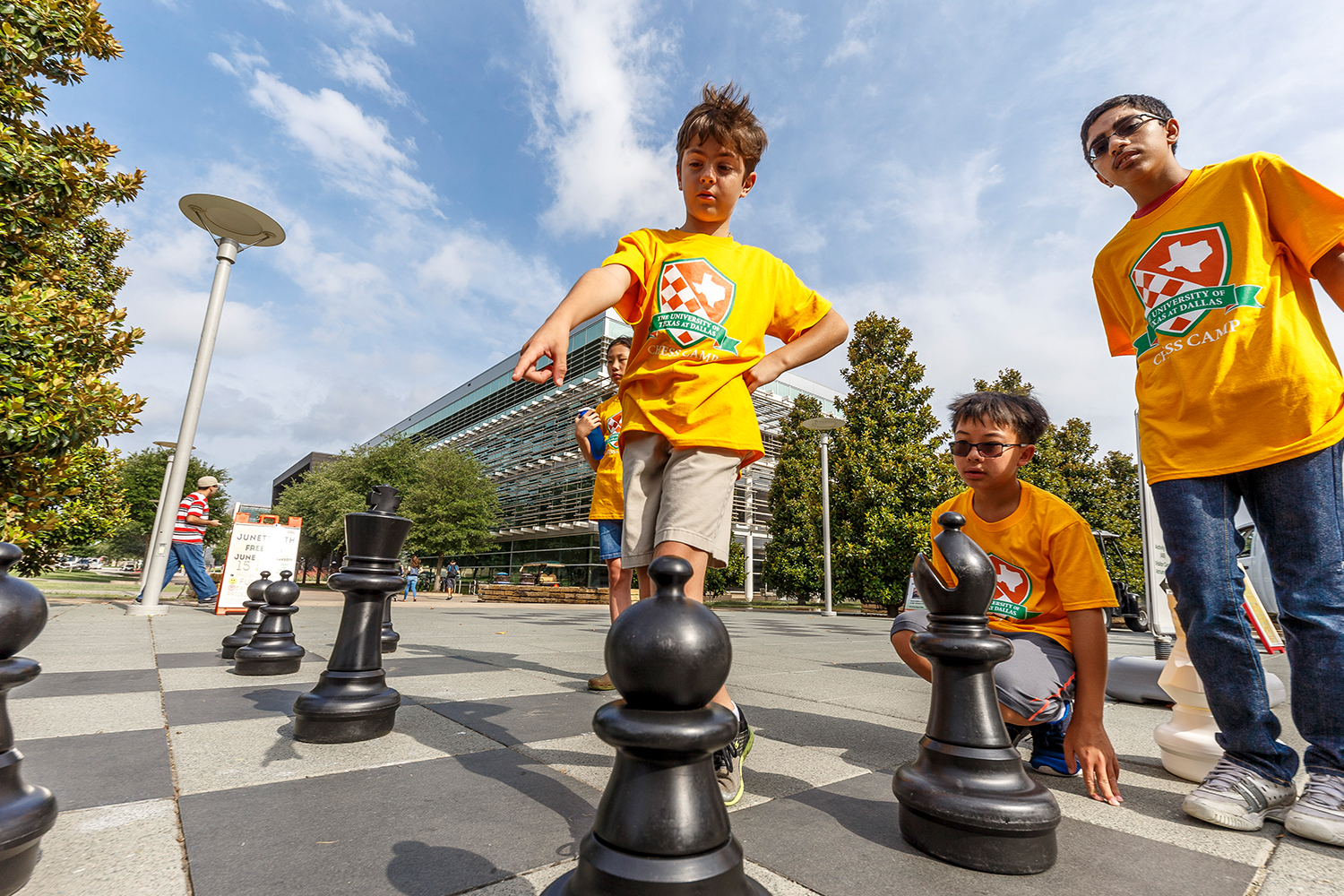 Campers play a game of chess with giant pieces at Chess Plaza in 2018.
Campers play a game of chess with giant pieces at Chess Plaza in 2018.
The University of Texas at Dallas features an array of summer camps for youths this year, with sessions focusing on topics including chess, performing arts and biology research. Here are some highlights:
In person. UT Dallas’ Callier Center for Communication Disorders, which offers support to children and adults with speech, language and hearing disorders, presents several summer camps for children and teens. One offering is a summer theater arts camp conducted with the UTD Doctor of Audiology program. This year, Camp Mary Poppins is presented in collaboration with Broadway Dallas and WaterTower Theatre. The weeklong performing arts day camp, July 16-20, is for deaf and hard-of-hearing children and their siblings in grades K-12. Other Callier Center camps include Camp Interact, a weeklong therapeutic day camp for children entering second through sixth grades with social skill difficulties, and Summer Language Camp, a six-week language therapy program for children ages 6 to 12 with language and learning disorders. Visit the Callier Center camps webpage for more information on these and other camps focused on reading and listening.
Online and in person. The UT Dallas chess program, one of the top collegiate programs in the U.S., presents camps providing training for players of all skill levels ages 8 to 17 in small classes. For the first time since 2019, the camps will include an in-person session for intermediate and advanced players taught by UTD chess coach and grandmaster Julio Catalino Sadorra BS’13. For more information, visit the summer chess camps webpage.
In person. The Center for Asian Studies is again offering the “Become a Gong Fu Panda!” camp for kids from 5 to 15. Campers can attend for one to three weeks June 10-28, and can build skills in Chinese language, kung fu, calligraphy, Chinese crafts and more. Visit the program webpage for more information.
In person and online. The Department of Computer Science is offering a nine-week research program for high school students who have already learned the material covered in the department’s summer camps. There are two types of research opportunities available: a competitive intensive research internship in a computer science lab for 20 to 40 hours per week or a summer research workshop that meets twice per week, much like a college class. The department is also offering an eight-week deep dive into artificial intelligence for college students and advanced-level high school students. Visit the program’s website for more information. For children and teens from third grade through high school, there are 18 different coding camps offered throughout the summer.
Other UTD summer camps and clinics for 2024 include:
Mean Green Comet Debate Institute (in person) for middle school and high school students.
Youth soccer — weeklong, full-day sessions for 5- to 12-year-olds.
Basketball developmental — weeklong, full-day sessions for 6- to 18-year-olds.
Elite volleyball – weekend full-day session for girls ages 14-18.
Esports – weeklong, full-day sessions for ages 7-17.
For the most up-to-date information on summer camps and classes, visit UT Dallas’ Programs for Minors webpage.
–Jessica Good
03.06.2024
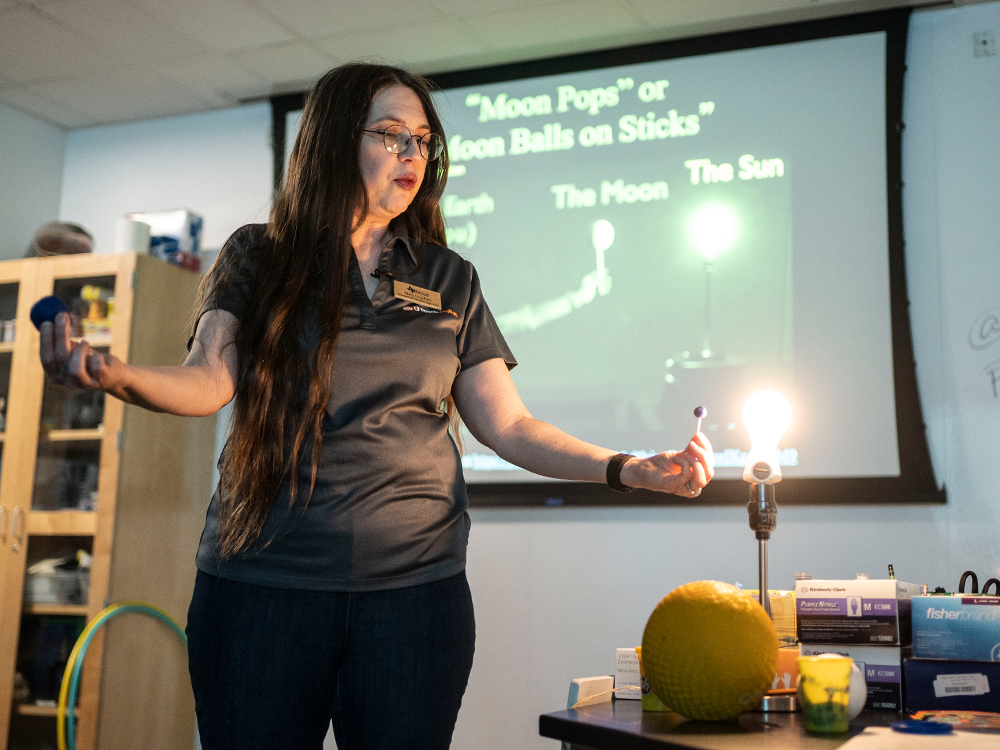 Dr. Mary Urquhart, department head of science/mathematics education at UT Dallas, uses props to demonstrate the sun-Earth-moon system to teachers.
Dr. Mary Urquhart, department head of science/mathematics education at UT Dallas, uses props to demonstrate the sun-Earth-moon system to teachers.
On a recent Saturday, more than 50 educators from North Texas went “back to school” at The University of Texas at Dallas to learn how to bring the excitement and science of the April 8 total solar eclipse to their classrooms.
Dr. Mary Urquhart, planetary scientist and associate professor and department head of science/mathematics education in the School of Natural Sciences and Mathematics, led the teacher workshop. She has already reached more than 450 Texas K-12 and college educators via free in-person and virtual teacher workshops about the eclipse.
Urquhart teaches astronomy and other related courses and directs the UTeach Dallas program, which prepares science and math majors for teaching careers. A leader in education outreach, she also develops curriculum and leads graduate and continuing-education programs for teachers.
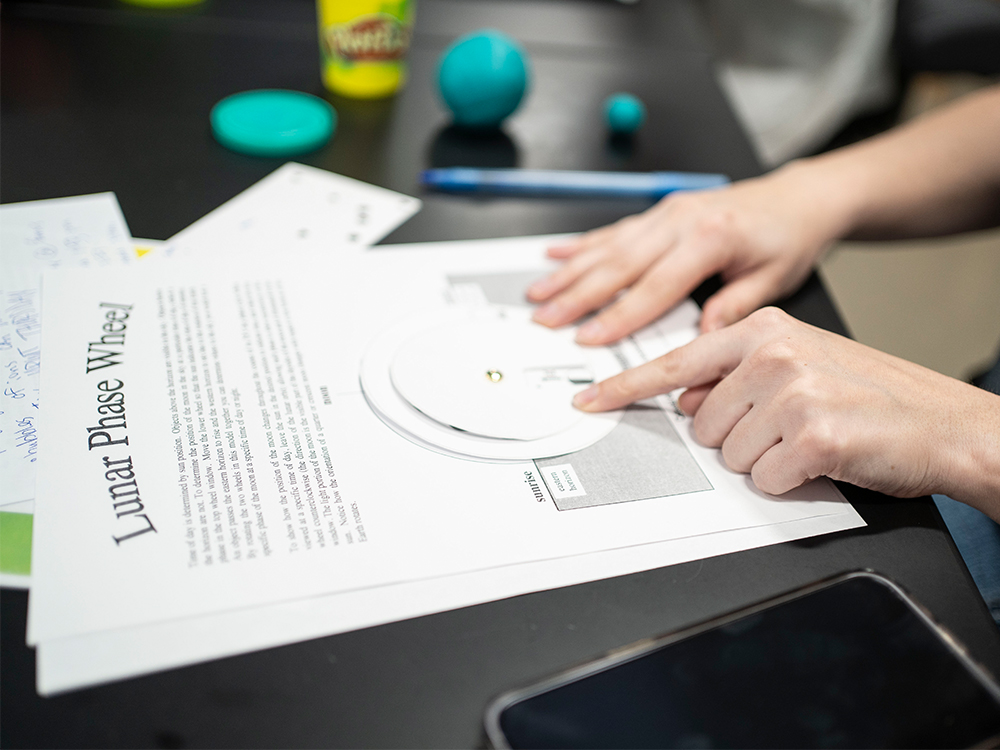 Teachers used a lunar phase wheel to understand how the phase of the moon relates to a solar eclipse.
Teachers used a lunar phase wheel to understand how the phase of the moon relates to a solar eclipse.
On April 8, the moon will pass between the sun and Earth, blotting out the sun and casting a shadow across a very narrow swath of the continental U.S. and parts of Mexico and Canada. The Dallas-Fort Worth area will be directly in the path of the total solar eclipse, which will bring a few minutes of darkness, or totality, during midday.
While some Texas school districts in the path of totality have canceled classes on April 8, many will still be in session. Urquhart said teachers come to the workshops to learn how to view the eclipse safely, as well as to get tips on hands-on activities and lessons to incorporate the eclipse into state curriculum standards.
Mohammad Saleh BS’21, MAT’23 teaches at J.J. Pearce High School in the Richardson Independent School District, which is supplying eclipse safety glasses to its students. Saleh attended the on-campus workshop seeking information about the solar eclipse that he could connect to his biology and environmental systems classes.
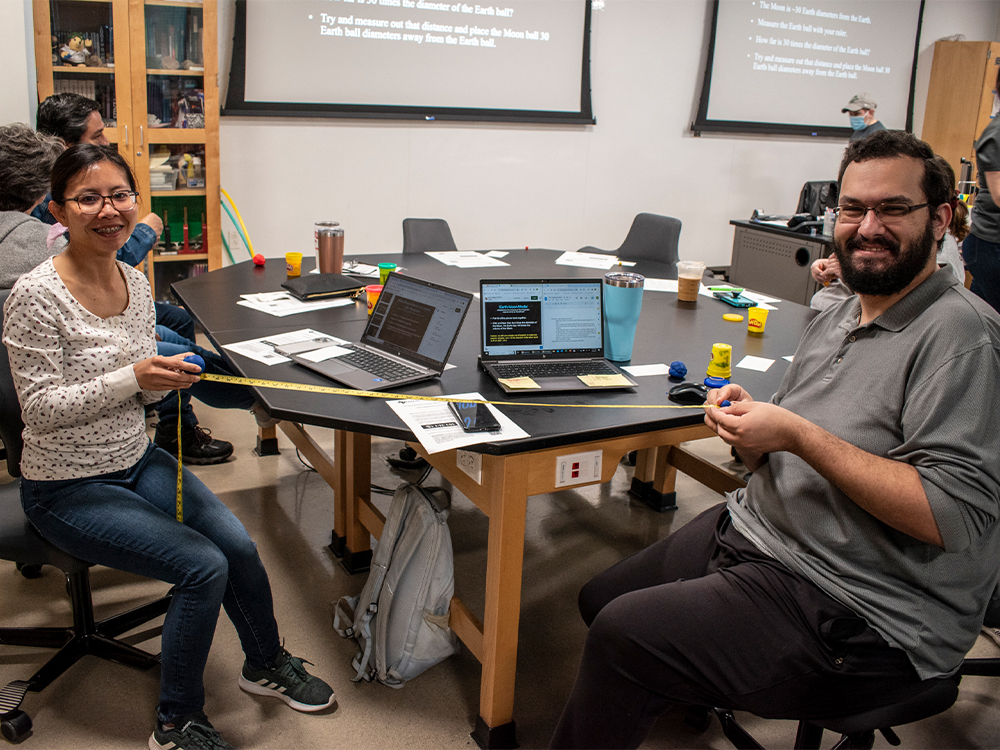 Ngoc Bui BS’23 (left), who teaches chemistry at Berkner High School and STEM Academy, and Mohammad Saleh BS’21, MAT’23, who teaches biology and environmental systems at J.J. Pearce High School, both in the Richardson ISD, shaped modeling clay into scale models of the Earth and moon.
Ngoc Bui BS’23 (left), who teaches chemistry at Berkner High School and STEM Academy, and Mohammad Saleh BS’21, MAT’23, who teaches biology and environmental systems at J.J. Pearce High School, both in the Richardson ISD, shaped modeling clay into scale models of the Earth and moon.
“The April event offers a unique opportunity to see how a solar eclipse affects humans and the environment,” Saleh said. “We’re going to have a mini-night in the middle of the day. I’d like to tie this to human circadian rhythms, as well as to how animals and insects behave differently during a total eclipse.”
Urquhart said teachers can incorporate aspects of the eclipse into many subject areas, from physical sciences and math to discussions of tides and atmospheric chemistry. During workshops, she orients toy plastic hoops to illustrate the orbit of the moon around the Earth and has teachers shape modeling clay into scale models of the moon and Earth.
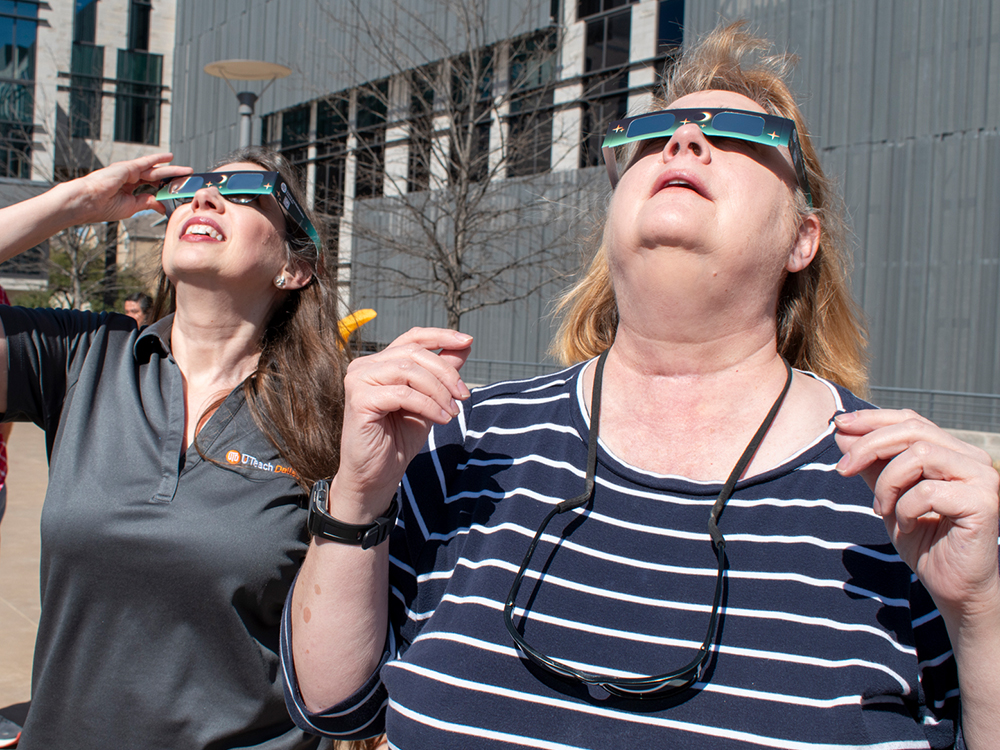 Amy Angel (right), who teaches fifth graders at Centerville Elementary School in the Garland ISD, joined workshop leader Dr. Mary Urquhart in practicing safe viewing of the sun using eclipse glasses.
Amy Angel (right), who teaches fifth graders at Centerville Elementary School in the Garland ISD, joined workshop leader Dr. Mary Urquhart in practicing safe viewing of the sun using eclipse glasses.
“I was looking for ideas on how to get my students excited about such a special event and ways to open their minds to nature and science,” said workshop participant Amy Angel, who teaches fifth graders at Centerville Elementary School in the Garland ISD. “I came away with a better understanding of the scale of the sun-Earth-moon system as well as some ideas on how to organize events at our school.”
During one workshop exercise, participants went outside and donned eclipse glasses to practice safely viewing the sun. They also viewed sunspots on a live projected image of the sun.
“It’s my department’s mission to support excellence in STEM education here in North Texas. Sharing excitement, science and safety for the upcoming rare celestial event of the total solar eclipse with classrooms and our community aligns with that mission. For us, that starts with supporting teachers, including the many UT Dallas alumni who are teaching in schools throughout the Dallas-Fort Worth area,” Urquhart said.
Educators can access eclipse resources on the Department of Science and Mathematics website.
–Amanda Siegfried
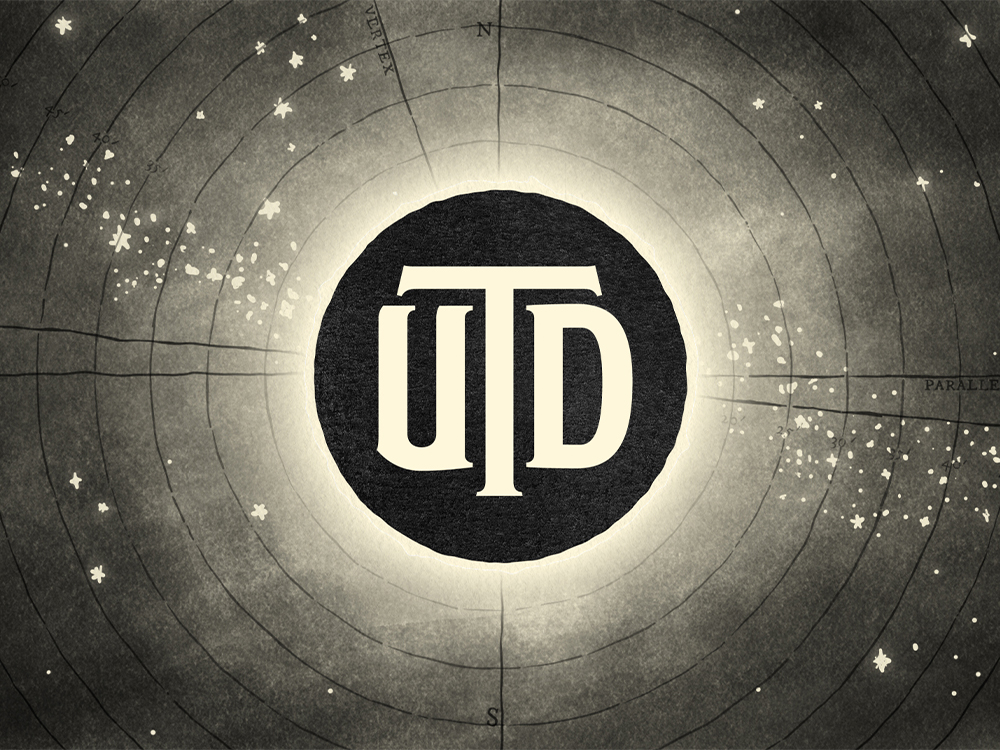
02.28.2024
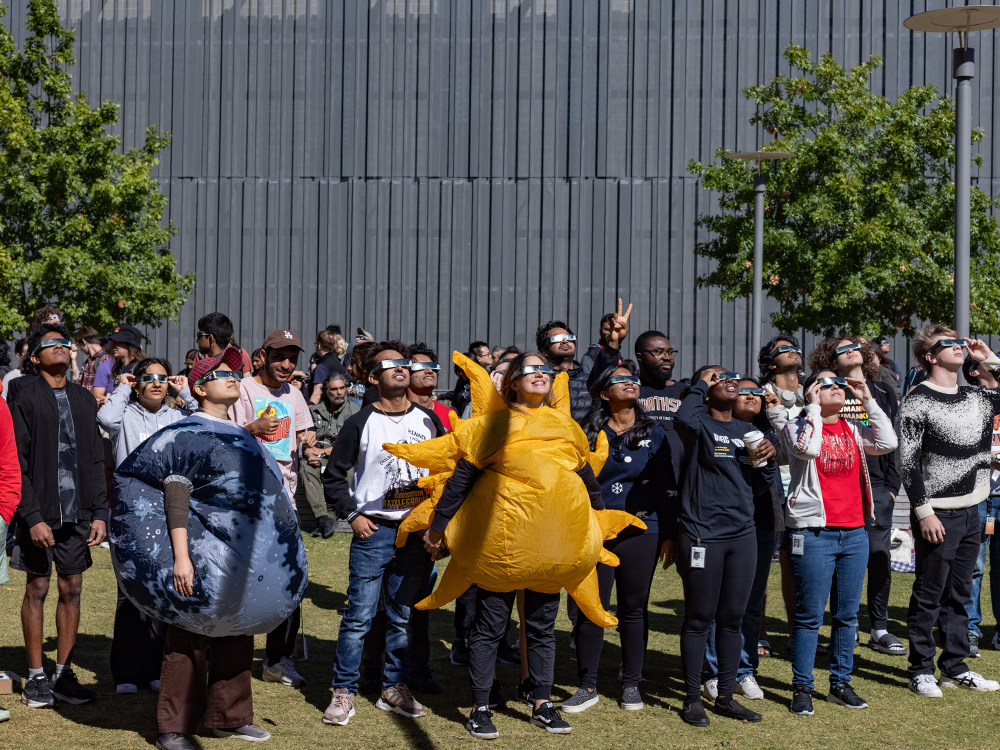 Members of the UT Dallas community view a partial solar eclipse in October 2023.
Members of the UT Dallas community view a partial solar eclipse in October 2023.
University of Texas at Dallas faculty members say the April 8 total solar eclipse that will be visible over most of the Dallas-Fort Worth area is a great opportunity for families to make lasting memories together and for employers to enhance job satisfaction among employees who want to experience the rare celestial marvel while on the clock.
“Eclipses have occurred throughout human history, and witnessing one can be a humbling, personal experience that can change the way we think about our place in the universe,” said Dr. Pamela Gossin, professor of literature and of the history of science at UT Dallas. “Sharing this natural event with friends and family is a collective, human experience, one that has been interpreted by people of different cultures around the world.”
Gossin teaches humanities courses in which she asks students to go outside and observe the moon, sunrises and sunsets over several weeks, and note changes.
“Students are blown away by this exercise,” she said.
“Some say they haven’t been alone in nature since they were kids,” Gossin said. “Especially growing up in a city like Dallas, some have never seen a star-filled sky. They are astounded to learn that if they watch the moon often enough, they might also catch sight of Jupiter, Saturn or Venus.”
After viewing the partial annular eclipse that passed through North Texas in October, Gossin’s students wrote about their experiences in personal essays. “It surprised them how much this natural experience mattered to them,” she said.
Gossin suggests that individuals and families who witness the April 8 total solar eclipse take time to reflect on the experience, either through personal essays or through creative interpretation, such as music or art. Families can encourage their children to draw pictures of what they saw or record audio of them talking about their experience.
And once the eclipse is over?
“Take time to go outside for 30 minutes – phones off,” she said. “Observing the moon or sunrises and sunsets together over days or weeks can be a chance for families to connect or reconnect, even in a large metro area.”
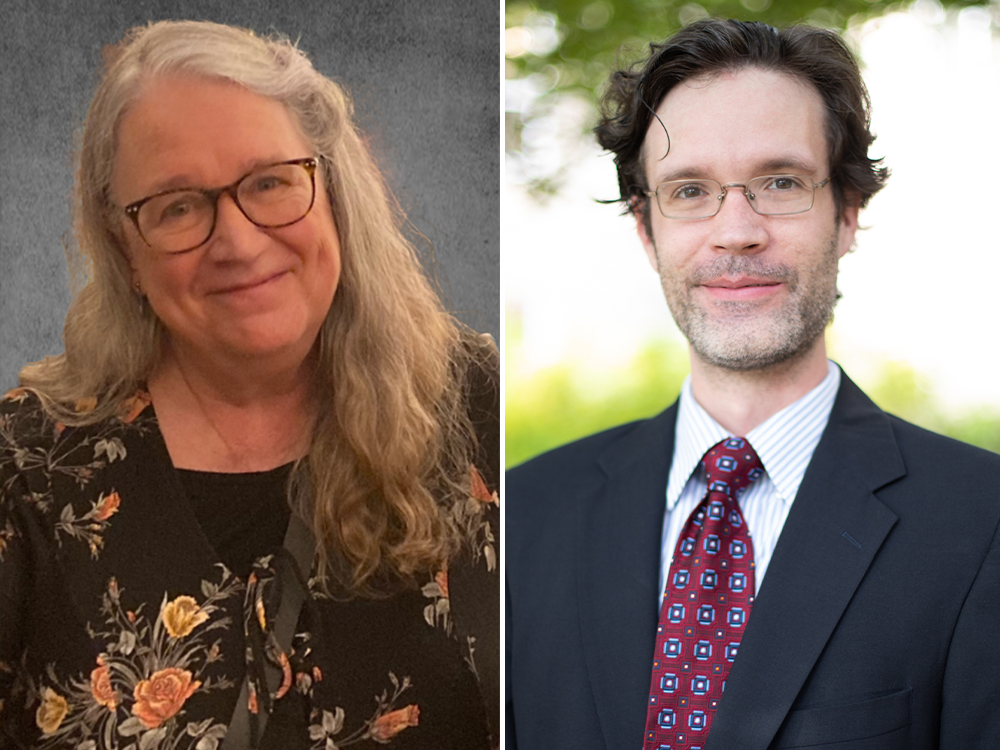 From left: Dr. Pamela Gossin, professor of literature and of the history of science, and Dr. Jason Kautz, assistant professor of organizations, strategy and international management.
From left: Dr. Pamela Gossin, professor of literature and of the history of science, and Dr. Jason Kautz, assistant professor of organizations, strategy and international management.
Dallas-Fort Worth employers might experience challenges involving their employees who want to experience the total solar eclipse during regular work hours. In North Texas, the eclipse will last from 12:20 p.m. to 3 p.m., with totality – when the sun is completely blocked by the moon – occurring around 1:40 p.m., depending on the location.
Dr. Jason Kautz, an assistant professor of organizations, strategy and international management in the Naveen Jindal School of Management, said organizations can capitalize on the eclipse for a relatively easy – and inexpensive – bump in employee job satisfaction, job engagement and organizational commitment.
“Doing something fun at work once in a while makes people excited and happy to go to work,” said Kautz, who researches and teaches courses in human resource management and organizational behavior.
Kautz offered these suggestions for employers to navigate the eclipse:
–Amanda Siegfried

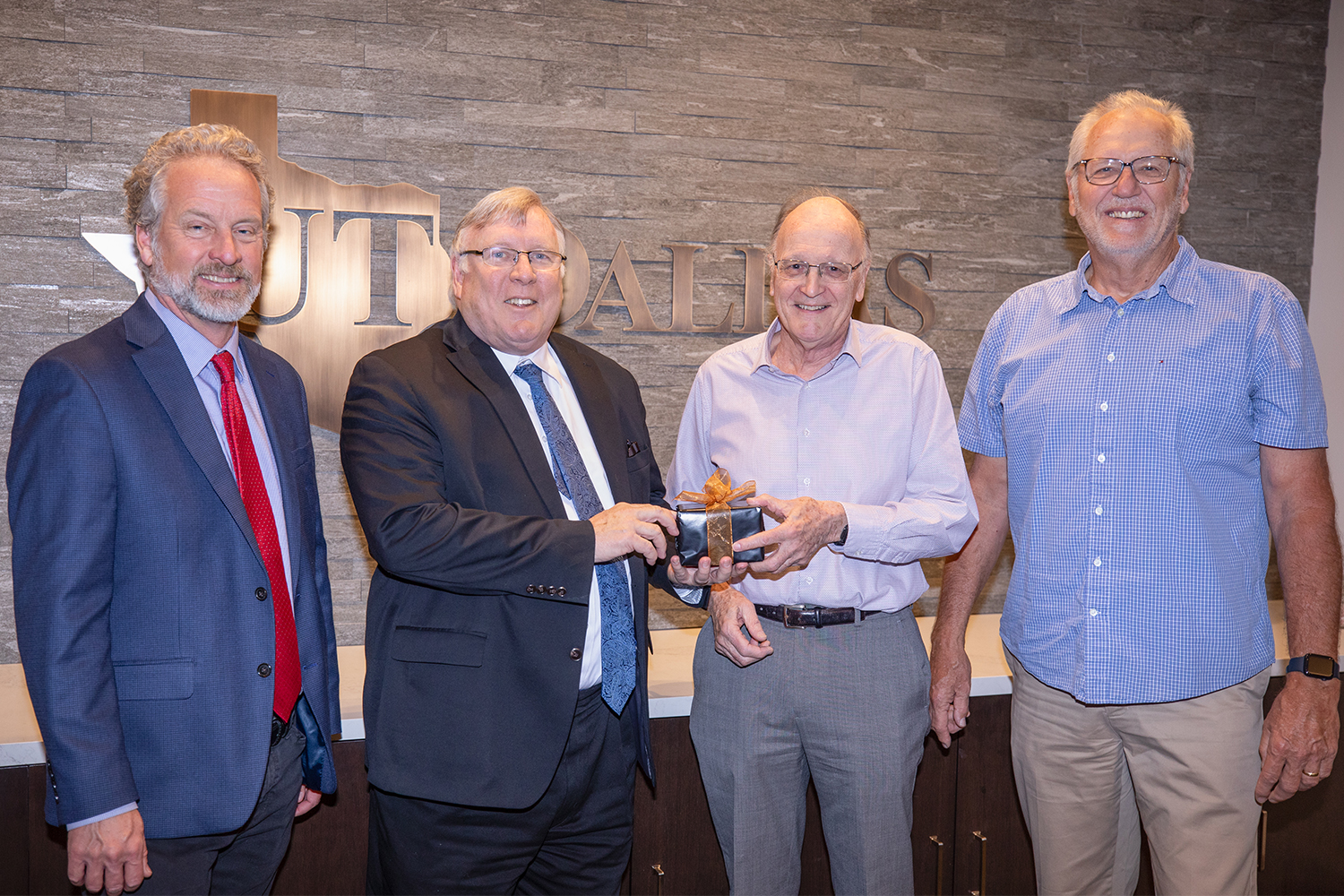 Dr. Roderick Heelis (second from right), former director of the William B. Hanson Center for Space Sciences, receives his 50-year service award from UT Dallas President Richard C. Benson in January. Joining the ceremony were Dr. David Hyndman (left), dean of the School of Natural Sciences and Mathematics, and Phillip Anderson MS’85, PhD’90, current director of the center.
Dr. Roderick Heelis (second from right), former director of the William B. Hanson Center for Space Sciences, receives his 50-year service award from UT Dallas President Richard C. Benson in January. Joining the ceremony were Dr. David Hyndman (left), dean of the School of Natural Sciences and Mathematics, and Phillip Anderson MS’85, PhD’90, current director of the center.
01.30.2024
When Dr. Roderick Heelis moved from Sheffield, England, to take a research scientist position at The University of Texas at Dallas in 1973, the 4-year-old campus was little more than a building in the middle of a cotton field.
Even so, the research program in atmospheric and space sciences, led by Dr. William B. Hanson, who recruited Heelis, was robust and well-funded through grants from NASA and other agencies. The program in the School of Natural Sciences and Mathematics is a carryover from UT Dallas’ precursor institution – the Southwest Center for Advanced Studies – which attracted top-caliber faculty in physics and astrophysics, as well as experts who designed space-based instruments to study the Earth’s upper atmosphere, the moon and other planets.
For 50 years, Heelis has conducted research on the ionosphere, a region of the upper atmosphere where disturbances can disrupt navigation systems and GPS signals to and from satellites. In January he received his 50-year service award – a watch bearing the UT Dallas seal – from University President Richard C. Benson, who is the Eugene McDermott Distinguished University Chair of Leadership.
“Over the years we have been fortunate to be at the forefront of science investigations that have a substantial impact on space-based communications and navigation,” Heelis said. “That, combined with our development of unique instrumentation for sensing charged particles in the atmosphere, has kept UTD in a great place for continued success.”
Heelis became director of the William B. Hanson Center for Space Sciences in 1994, succeeding Hanson.
“In the early days of UTD, parking lots C and D used to be well-mown fields, where Bill Hanson and I would hit golf balls after work,” Heelis recalled. “Those times led to some pretty good ideas for new science and new instruments, and a drive down what is now Bryce Jordan Drive still brings a smile to my face.”
Heelis was a Distinguished Chair in Natural Sciences and Mathematics when he stepped down as the Center for Space Sciences director in 2022. Phillip Anderson MS’85, PhD’90, a professor of physics who succeeded Heelis as center director, said he considers himself fortunate to have had Heelis as a mentor, colleague and friend for nearly 40 years. Heelis was part of his PhD committee.
“Rod is one of the giants in our field. His contributions are tremendous and include well over 200 publications with over 7,000 citations,” Anderson said. “He has been responsible for the production and deployment of numerous spacecraft and rocket instruments and several scientific advancements in space science research. He is also an excellent teacher, one of the very best at UTD.”
Heelis carries on his work as a research professor as he splits his time between UT Dallas and Logan, Utah, where he said he hopes to retire – someday.
“As the University has grown, so, too has the Center for Space Sciences,” Heelis said. “I am particularly proud to have assembled such a talented group of scientists and engineers who have remained in the center and nurtured its growth alongside me. Such a well-functioning group allows everyone to operate at their best.”
–Amanda Siegfried
11.01.2023
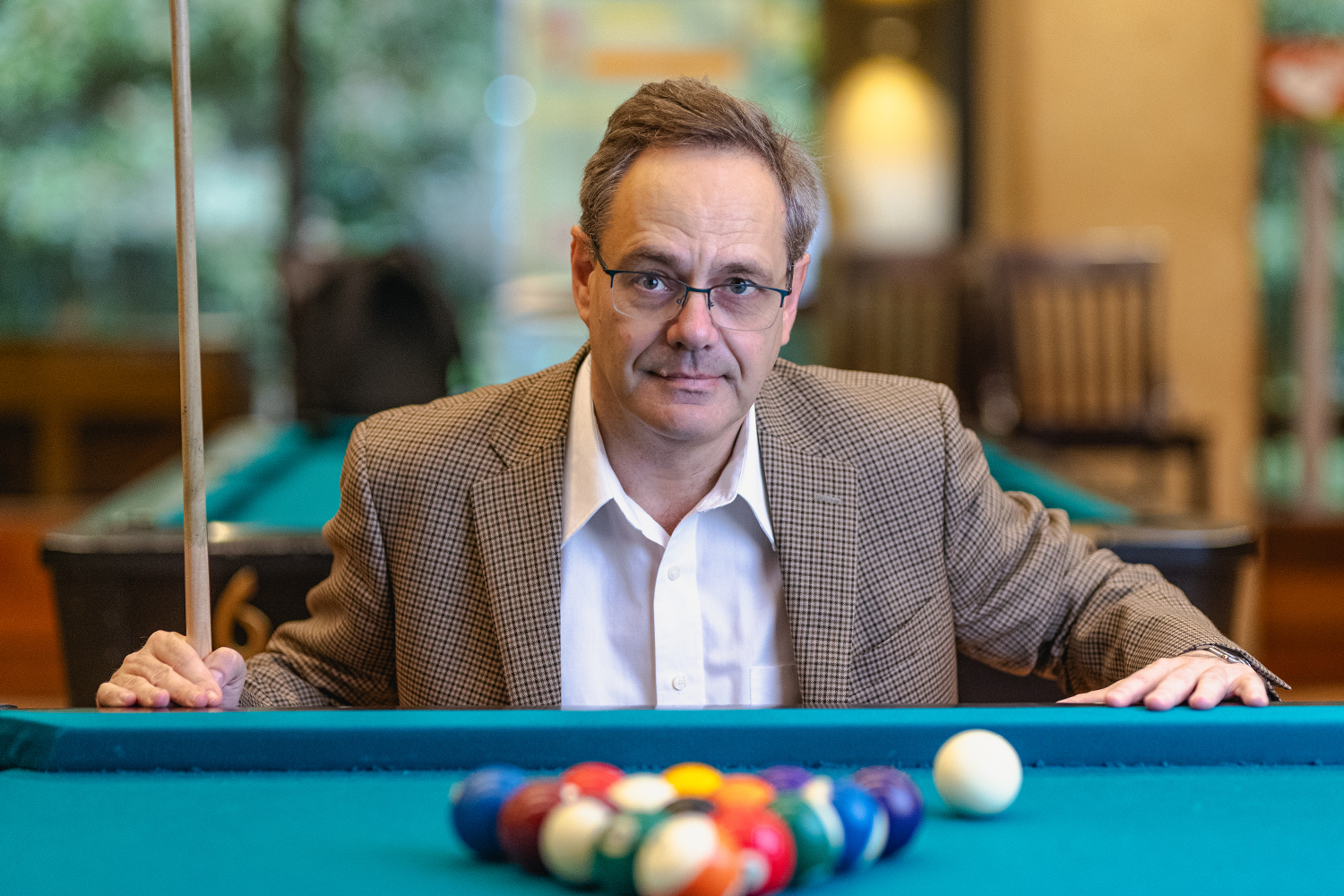 Dr. Vladimir Dragovic
Dr. Vladimir Dragovic
At The University of Texas at Dallas, faculty members who specialize in theoretical mathematics add an important dimension to the University’s research portfolio.
Dr. Vladimir Dragovic, professor and head of mathematical sciences in the School of Natural Sciences and Mathematics, is an expert in mathematical billiards. It’s a field that has applications in physics and engineering, but Dragovic is drawn to the beauty of theory.
Dragovic was invited to be a featured course lecturer this fall at a 10-week program on mathematical billiards and applications hosted by the Simons Center for Geometry and Physics at Stony Brook University. During the program, researchers from around the world present a series of lectures and a workshop on billiard-type dynamics.
In the physical world, billiards and its cousin, pool, are played on a flat, typically rectangular surface, with several balls that are contained within the table’s 2D boundary. Game play includes using the tip of a cue to tap a designated ball, which travels in a line to carom off the walls of the table and/or collide with other balls.
While the principles are the same in mathematical billiards, the theoretical game can take on exotic configurations. Balls become point particles that bounce, or reflect, off boundary walls, while the table can be shaped like an oval, triangle or hexagon. The table surface can be non-flat. And the balls can move within boundaries expanded to three or more dimensions, such as spheres and ellipsoids.
“Mathematical billiards can be a model for many physical systems,” Dragovic said.
For example, in gas dynamics, as in billiards, particles collide and reflect off boundaries and one another. The theory also describes how light rays – which reflect like balls bouncing off a wall – illuminate mirrored rooms of various shapes. Other applications include acoustics, quantum physics, cosmology, particles moving inside nanodevices and computer graphics.
 In 2008, Dr. Vladimir Dragovic visited an exhibition on “living mathematics” at the Pavilion of Knowledge Centro Ciência Viva in Lisbon, Portugal, that featured billiard tables in unusual shapes. He demonstrated his skills on an elliptical table.
In 2008, Dr. Vladimir Dragovic visited an exhibition on “living mathematics” at the Pavilion of Knowledge Centro Ciência Viva in Lisbon, Portugal, that featured billiard tables in unusual shapes. He demonstrated his skills on an elliptical table.
Dragovic’s research focuses on elliptical billiards in 2D planes as well as their analogs in higher dimensional spaces. In recent years, he has combined ideas from this line of work with several different theoretical areas, including approximation theory, extremal polynomials, algebraic geometry, harmonic analysis and combinatorics, in unexpected ways that have led to new results and insights in each field. His work has been funded continuously over the last two decades by various agencies, including the National Science Foundation and the Simons Foundation, as well as the International Discovery Award from the Australian Research Council. It has led to several publications in journals such as Advances in Mathematics, Bulletin of the American Mathematical Society and Communications in Mathematical Physics.
“Mathematical billiards is a field where it is easy to pose questions but difficult to answer them,” Dragovic said. “For example, consider a triangular-shaped boundary for billiards. It is relatively easy to show that in each acute and right triangle there is a periodic trajectory, which means a moving ball will carom off the walls but will eventually return to its starting point.
“But if you ask whether there is a periodic trajectory in an obtuse triangle with an angle greater than 100 degrees, this is still an open question. Whether it is applied or theoretical, mathematics is important and fascinating in all its beauty and manifestations.”
Growing up in Belgrade, Serbia, and as a student at the University of Belgrade, Dragovic and his friends often played miniature golf and sometimes pool. He said engaging in these types of geometrical challenges with a mathematician shouldn’t take the fun out of the game.
“Being an expert in mathematics and being an expert in pool or mini golf are completely different things – being good in one does not mean you are good in the other,” Dragovic said. “On the other hand, to be an expert in these real games requires hours and hours of practice, just as being an expert in mathematics requires years and years of a different kind of practice.”
–Amanda Siegfried
10.30.2023

When the weather turns cooler, local coffee shops are blanketed with orders for pumpkin spice lattes.
But did you know that the warm fuzzies you get when you drink the popular fall beverage have nothing to do with pumpkins? It’s all a scientific ruse — chemical compounds in the ingredients result in the brain recalling things like pumpkin pie or spiced cider, evoking memories related to the season.
“You don’t actually get pumpkin-spice flavoring from pumpkins,” said Dr. Ron Smaldone, associate professor of chemistry and biochemistry in the School of Natural Sciences and Mathematics at The University of Texas at Dallas. “It’s part of this experience when you taste something. It’s not just a chemical response; it’s also an emotional response or a response to experiences you’ve had.”
Smaldone and Dr. Christina Thompson, associate professor of instruction in the Hobson Wildenthal Honors College and a member of the Smaldone Research Lab, teach a Collegium V Honors course — Culinary and Food Chemistry — that explores food and cooking through a scientific lens.
As part of the Office of Research and Innovation’s Research Days showcase, the professors recently participated in a public forum focused on coffee. Gary Cocke, UT Dallas director of sustainability and energy conservation, gave an overview of sustainability in agriculture and the benefits of composting, while representatives from White Rock Coffee delved into the history of coffee and the bean-roasting process – while providing a variety of coffee drinks.
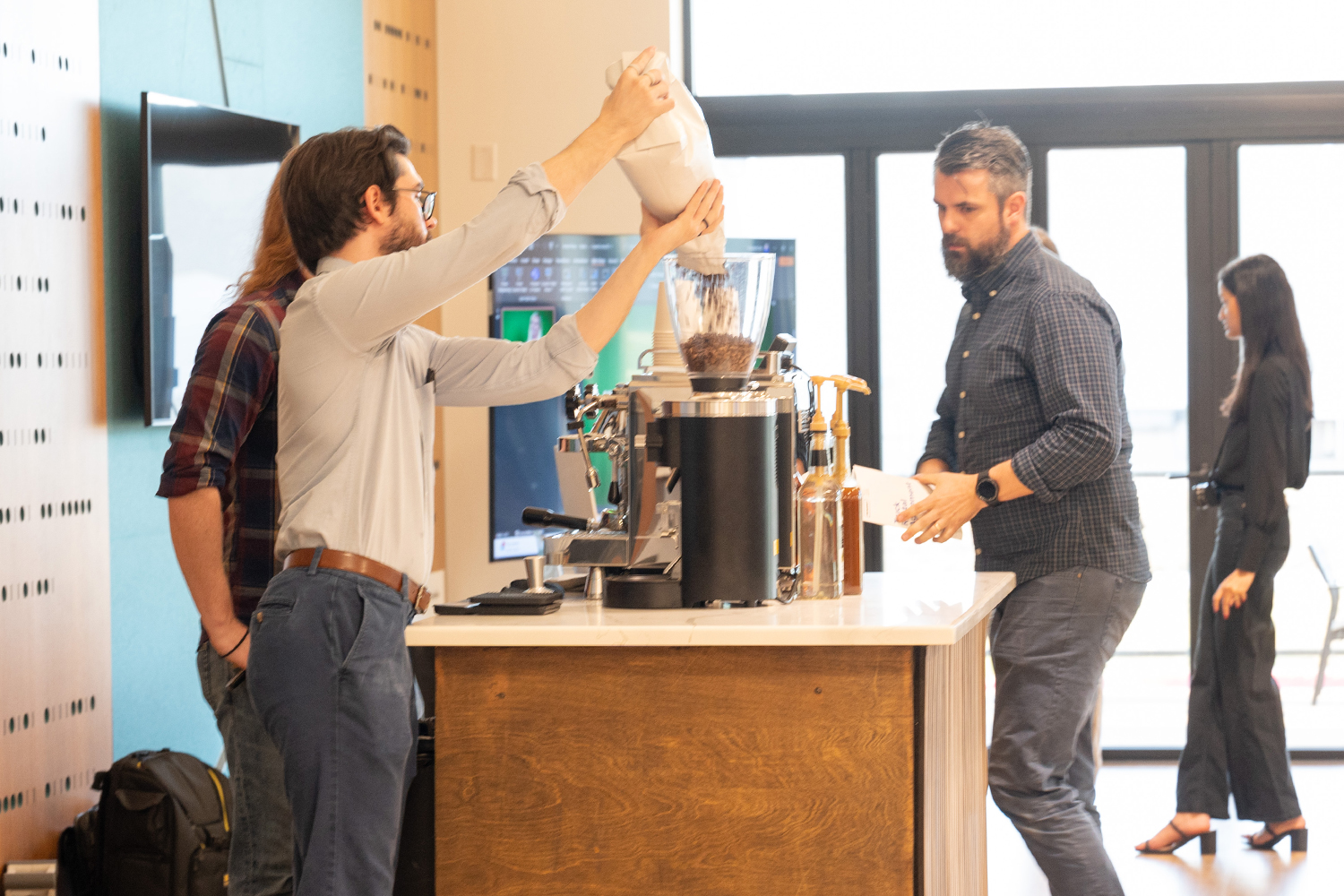 Representatives from White Rock Coffee prepare a fresh brew for attendees of a recent Research Days showcase, hosted by the UT Dallas Office of Research and Innovation.
Representatives from White Rock Coffee prepare a fresh brew for attendees of a recent Research Days showcase, hosted by the UT Dallas Office of Research and Innovation.
Smaldone and Thompson focused on the chemistry involved in coffeemaking and how molecules from food and beverages can enhance the gastronomic experience.
“One part of eating or experiencing any kind of food is that you smell it,” Smaldone said.
Chemical receptors in the nose recognize molecules from food and send signals to the brain, resulting in a unique experience that often encodes a strong memory. A whiff of the same smell, even years later, can bring back that memory and its associated emotions, Smaldone said.
Thompson described the extraction process of coffee making and all the variables that can affect how a cup of coffee turns out, such as the temperature of the water used (95 degrees Celsius or 203 degrees Fahrenheit is optimal), how long the water and coffee are in contact, and the size of the coffee grounds.
“All those thousands of delicious little molecules are concentrated in a solid coffee bean, and we want to get them into a liquid,” Thompson said. “A cup of coffee is about 2% coffee and 98% water — that’s not a lot of coffee molecules. But your tongue — and really your nose — are excellent at tasting these things, so you don’t need very much.”
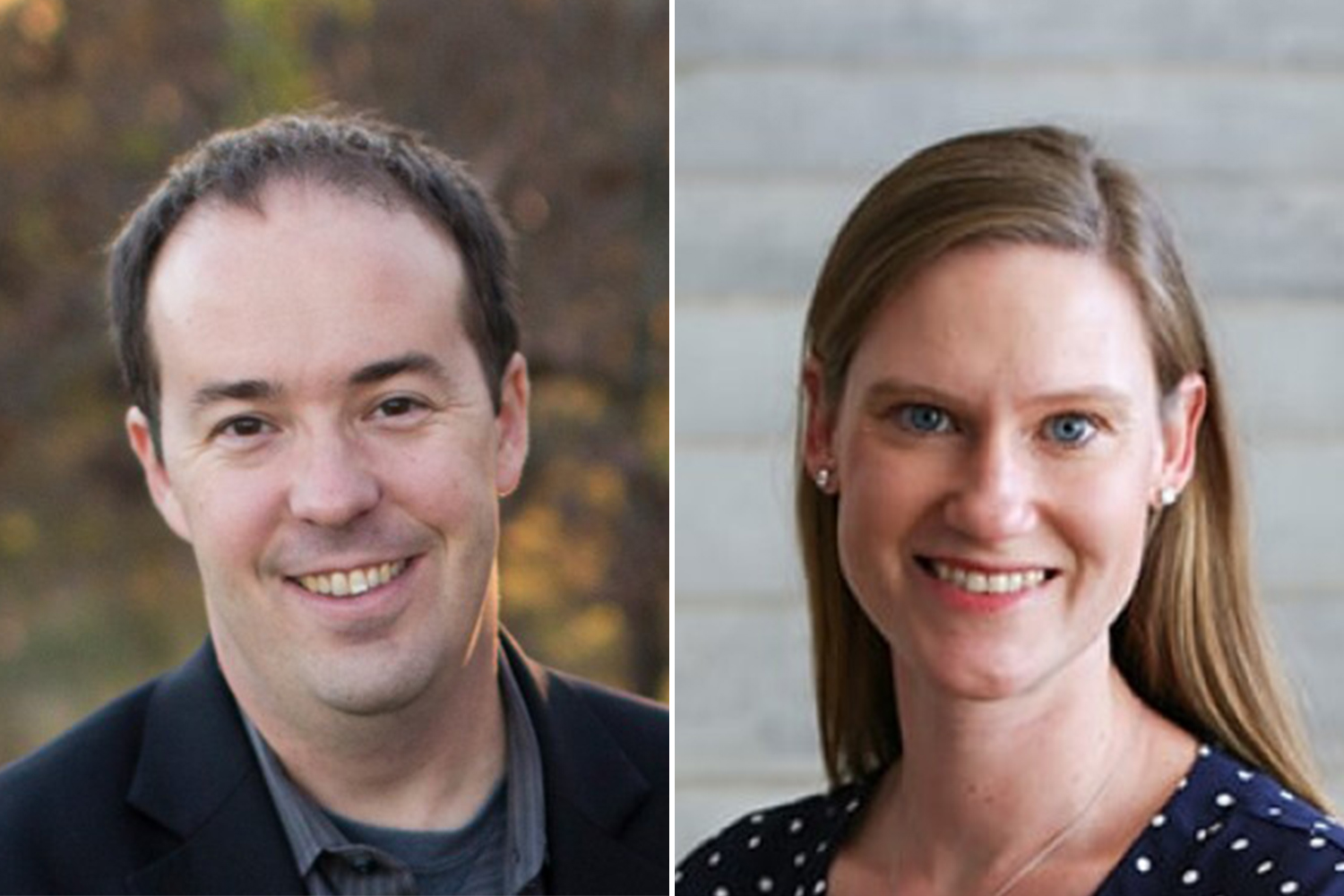 Dr. Ron Smaldone (left) and Dr. Christina Thompson
Dr. Ron Smaldone (left) and Dr. Christina Thompson
Thompson said very fine grinds have a lot of surface area, so they extract flavors quickly. Meanwhile, larger grounds have less surface area, so they need more time.
“Less-extracted coffee tends to have more of a sour, thin taste because you are missing out on the larger, slower extracting molecules that tend to have more of the caramel, toast and smoky attributes,” Thompson said. “On the other extreme, over-extracted coffee tends to be bitter and taste a bit like charcoal because you’ve extracted too many of those large flavor molecules that have those flavor profiles.”
The key takeaway: Find the right combination of grind size and extraction time so that the coffee comes out the way you want.
“Most home drip coffeemakers have a set amount of time the coffee is in contact with the hot water, so you can tune the coffee’s flavor by changing the amount of coffee you add or how finely you grind it,” Thompson said.
Thompson’s favorite coffees are medium roasts with nut flavors, while Smaldone prefers dark-roasted coffee — it’s less acidic — with malty and caramel flavors.
–Paul Bottoni
10.04.2023
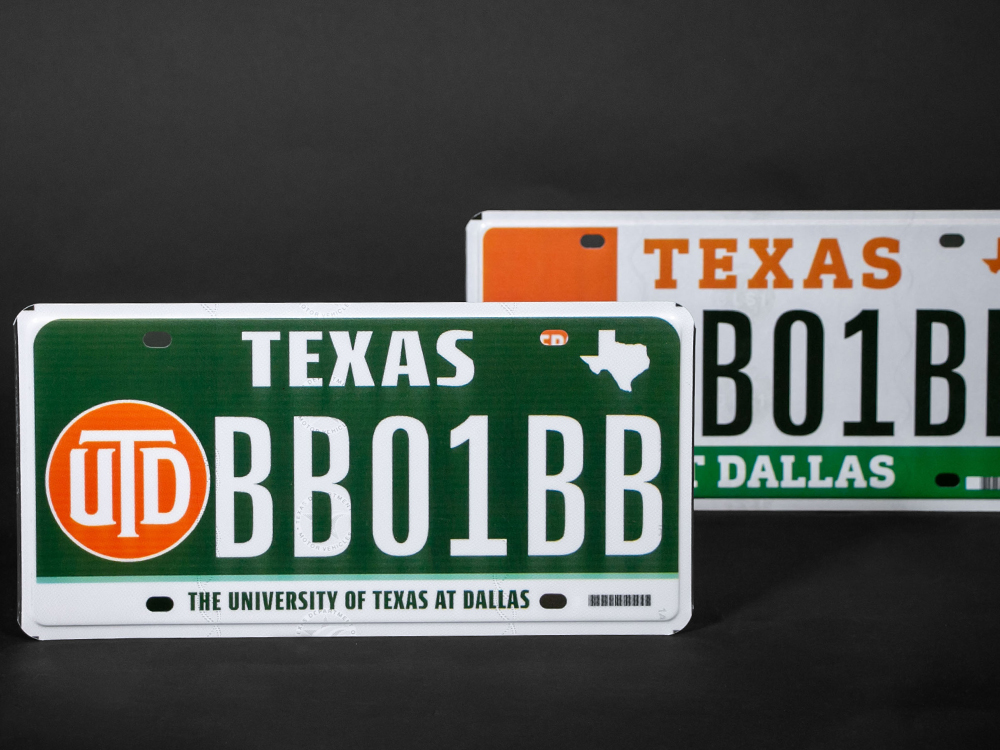 The new University of Texas at Dallas license plate (left) features an updated design and can be personalized with up to six characters.
The new University of Texas at Dallas license plate (left) features an updated design and can be personalized with up to six characters.
University of Texas at Dallas students, faculty, staff and supporters have a stylish new way to show off their Comet pride. The University has launched a redesign of its specialty Texas license plate, which is available for personalization and purchase.
UT Dallas President Richard C. Benson purchased one of the first new plates, which includes updated colors and up to six characters of personalization.
“I love my handsome new UTD plate,” said Benson, the Eugene McDermott Distinguished University Chair of Leadership. “It’s amazing how many alumni and friends of UTD make a point of saying, ‘Hi,’ in parking lots.”
Kent Best, associate vice president for marketing, said when the opportunity to redesign the plate presented itself, he and his team jumped on it.
“The old plate had been around for several years and needed a fresh look,” he said. “We chose the dark green background and orange circle UTD to make sure our plates pop with color on the highway. Our creative director, LeeDon Moore, designed the plate with that thought in mind.”
Along with letters and numbers, special characters including a heart, silhouette of Texas, lone star, and the International Symbol of Access can be featured on a personalized plate.
Plates are available for purchase through the Texas Department of Motor Vehicles with one-, three- and five-year terms for passenger vehicles. The UT Dallas community has two options when purchasing plates: Specialty plates with random letters and numbers are $35 per year, depending on the length of the term selected, and personalized plates are $90. Customers can transfer their current personalized license plate message to the UTD plate. Visit myplates.com for more information.
Best hopes Comets will check out the redesigned license plates.
“We encourage all Comets to get one of the new plates. A portion of the proceeds comes back to UTD, and you become a mobile brand ambassador for the university we love.”
–Jessica Good
09.18.2023
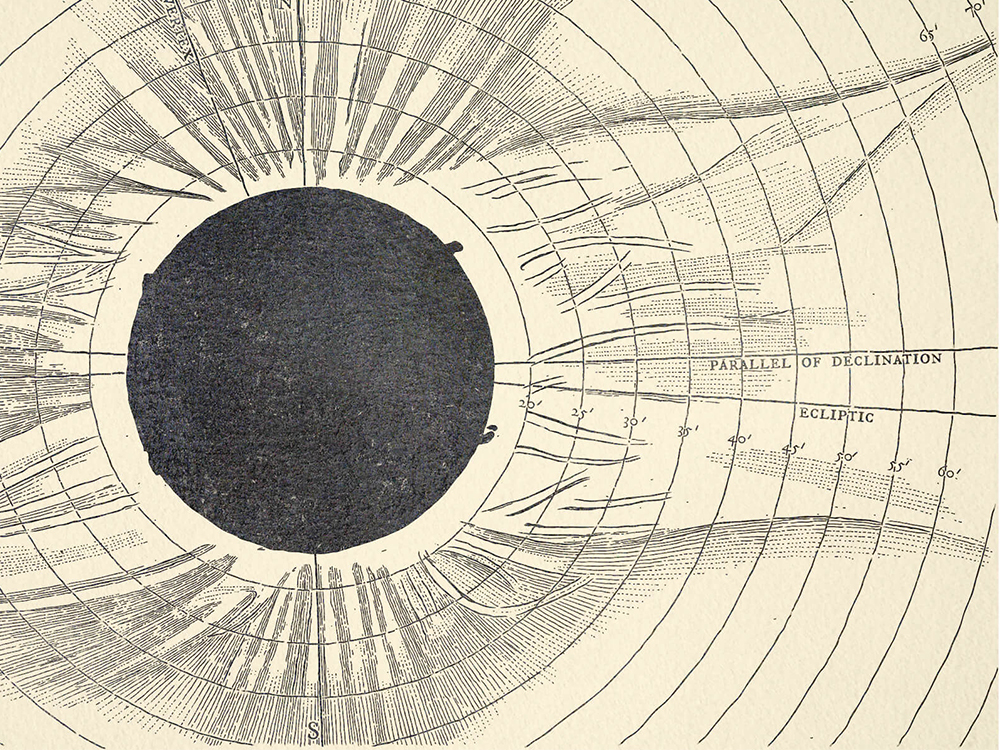
If you ask someone who has witnessed a total eclipse of the sun to describe the experience, they will likely use adjectives such as exhilarating, spiritual or life-changing. More profound, however, will be their emotional connection to the experience – not only to the eclipse itself, but also to the place where it occurred.
Next spring, on April 8, tens of thousands of students, staff and faculty will experience this event of a lifetime at The University of Texas at Dallas. The campus will be directly in the path of a rare total solar eclipse. During totality, the moon will pass between the sun and Earth and blot out the sun for approximately four minutes. The next total solar eclipse to pass over a large swath of the continental U.S. will not occur until 2045.
But before that memorable moment, Comets can practice their viewing skills Oct. 14, when a partial solar eclipse will be visible in North Texas. Over UT Dallas, the moon will cover about 80% of the sun, while parts of Southwest Texas will experience an annular solar eclipse. This type of eclipse is similar to a total eclipse, except the moon does not completely cover the sun; it leaves visible the thin “ring of fire” of the sun’s disk. Texas will not experience another annular solar eclipse until 2077.
For eclipse-related information, including campus events, safe-viewing tips, science and history blogs, and FAQs, visit the UT Dallas eclipse website, which will be updated as the eclipses draw near.
–Amanda Siegfried
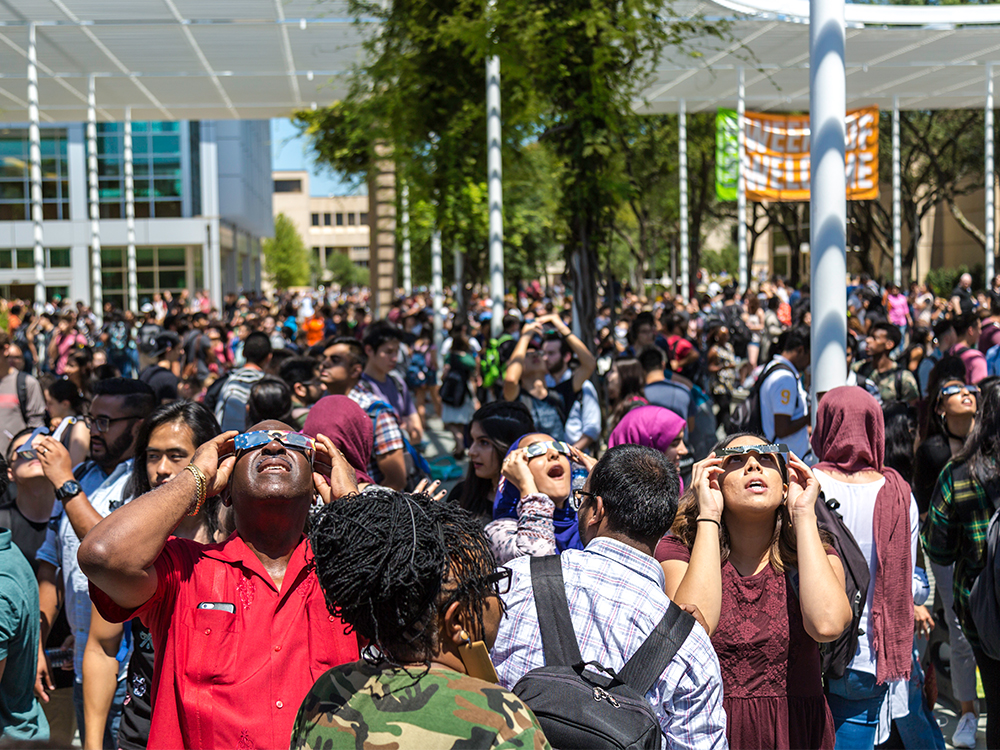 On Aug. 21, 2017, there was a stellar scene on the Margaret McDermott Trellis Plaza at The University of Texas at Dallas, when the campus community gathered to witness a solar eclipse. Equipped with safety glasses, Comets took turns glimpsing the cosmic event, and even though North Texans only saw a partial eclipse, it was still quite a sight to see. UT Dallas will be in the path of a total solar eclipse on April 8, 2024.
On Aug. 21, 2017, there was a stellar scene on the Margaret McDermott Trellis Plaza at The University of Texas at Dallas, when the campus community gathered to witness a solar eclipse. Equipped with safety glasses, Comets took turns glimpsing the cosmic event, and even though North Texans only saw a partial eclipse, it was still quite a sight to see. UT Dallas will be in the path of a total solar eclipse on April 8, 2024.